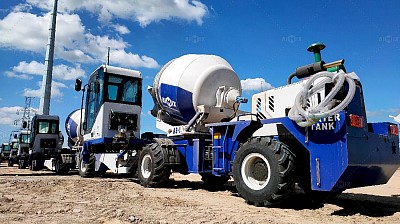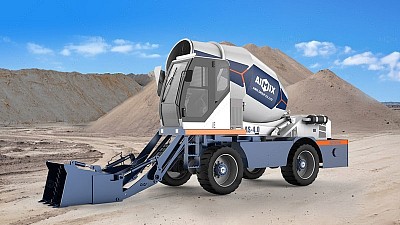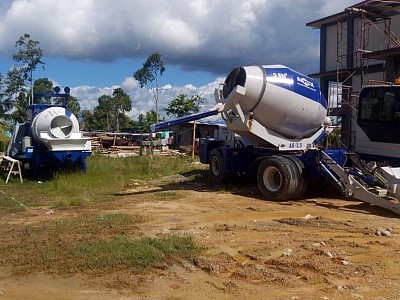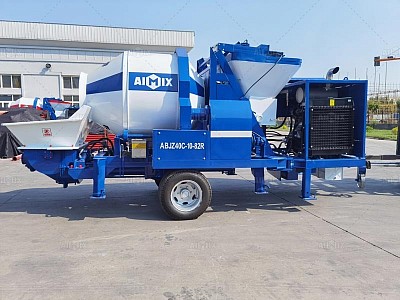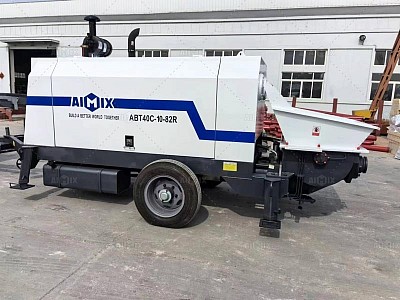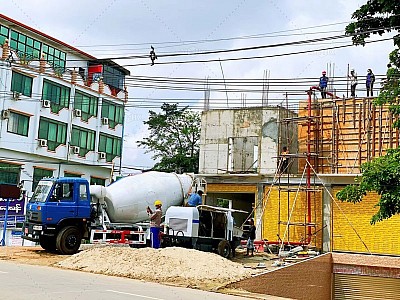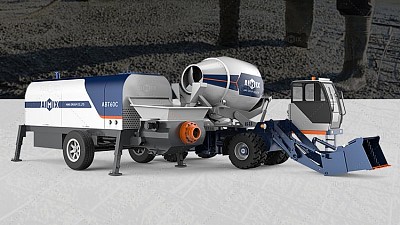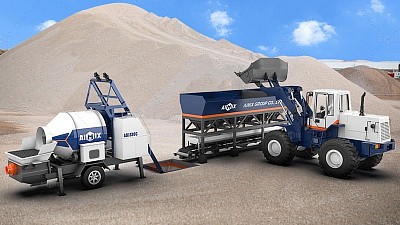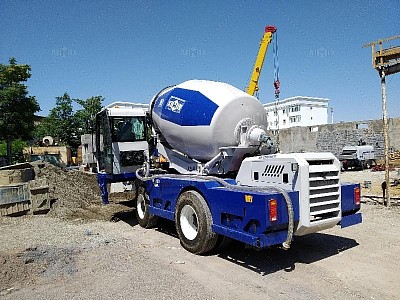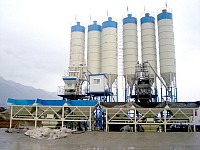Blogs about different equipments
Exploring Self Loading Concrete Mixer Options in Colombia
When it comes to construction projects in Colombia, finding the right self loading concrete mixer is essential for efficiency and productivity. These versatile machines are indispensable for road construction, bridge projects, and other demanding tasks. However, with so many options available, it’s important to make an informed decision. This article will guide you through the process of selecting the best self loading concrete mixer while considering features, reviews, and prices.
Why Choose a Self Loading Concrete Mixer?
Self loading concrete mixers are a game-changer in the construction industry. They combine the functions of a loader, mixer, and transporter, making them highly efficient for on-site concrete production. Here’s why they’re ideal for road and bridge construction:
1. On-Site Concrete Production
Self loading mixers allow you to produce fresh concrete directly on-site, ensuring high-quality output without delays. This is especially beneficial for remote construction sites where access to ready-mix concrete may be limited.
2. Reduced Labor Costs
With automated loading, mixing, and transportation, these machines significantly reduce the need for manual labor, saving time and money.
3. Versatility
From small-scale residential projects to large infrastructure developments, self loading mixers can handle various types of concrete mixes and adapt to different terrains.
Tips for Finding the Right Self Loading Concrete Mixer
When searching for a self loading concrete mixer price(hormigonera autocargable precio) that fits your budget, it’s important to follow these steps:
1. Compare Prices Across Sellers
Prices for self loading concrete mixers can vary widely. Take the time to research and compare costs from multiple sellers. If a seller’s price is significantly higher than the market average, ask if they can offer a discount or additional features to justify the cost.
2. Look for Sales and Discounts
Keep an eye out for seasonal sales or holiday promotions. Many companies offer discounts during specific times of the year, allowing you to save money. However, be cautious of companies that inflate prices before offering a “discount.”
3. Read Customer Reviews
Customer reviews are invaluable when evaluating the quality and performance of a self loading concrete mixer. Look for consistent feedback regarding reliability, durability, and ease of use. If multiple reviewers highlight the same issue, it’s likely a genuine concern.
Evaluating Features and Performance
To ensure you’re getting the best value for your investment, consider the following aspects of a self loading concrete mixer:
1. Machine Specifications
Understand the capacity, mixing speed, and engine power of the mixer. These factors determine its suitability for specific projects, such as large-scale road construction or smaller bridge repairs.
2. Ease of Operation
A user-friendly machine can save time and reduce the learning curve for your team. Check if the mixer comes with clear instructions and intuitive controls.
3. Durability and Maintenance
Construction sites can be harsh environments, so durability is key. Opt for a mixer made from high-quality materials that can withstand heavy use. Additionally, consider the availability of spare parts and maintenance services in Colombia(servicio de autohormigonera en Colombia).
Making an Informed Purchase
Before finalizing your purchase, take these additional steps to ensure you’re making the right choice:
1. Test the Mixer
If possible, test the mixer to evaluate its performance. This is particularly important for used machines, as it allows you to identify any potential issues.
2. Review the Warranty and Insurance Options
A warranty provides peace of mind by covering potential repairs. If the mixer will be used on public roads, ensure it’s covered by appropriate insurance.
3. Understand the Manual
Take the time to review the user manual. This will help you understand the mixer’s features, maintenance requirements, and any limitations that could impact your projects.
Conclusion: Invest in the Right Self Loading Concrete Mixer
Finding the perfect self loading concrete mixer price in Colombia requires research and careful consideration. By comparing prices, reading reviews, and evaluating machine features, you can make a smart investment that enhances your construction operations. Whether you’re building roads, bridges, or other infrastructure, a reliable self loading concrete mixer will ensure efficiency, quality, and cost savings.
Take your time, follow the tips outlined above, and you’ll soon have a mixer that meets your needs and exceeds your expectations.
5 Benefits of Investing in a Self-Loading Concrete Mixer
Concrete mixers have been a staple in construction for centuries, evolving from simple hand-operated systems to advanced machinery. Among the most innovative types of mixers today is the self-loading concrete mixer. This modern equipment has become a game-changer for construction businesses due to its ability to simplify concrete mixing and transportation, making it a must-have for many companies in the industry.
What is a Self-Loading Concrete Mixer?
A self-loading concrete mixer(hormigonera autocargante) is a powerful and efficient machine designed to load, mix, and discharge concrete. It features an articulated arm connected to a rotating drum, which is operated by the driver from inside the cab. This multifunctional machine combines the roles of loading, mixing, and transporting concrete, making it an essential tool for construction sites worldwide.
Key Benefits of Investing in a Self-Loading Concrete Mixer
If you're in the construction industry, investing in a self-loading concrete mixer can provide significant advantages. Below, we explore 5 key benefits that make this equipment a smart choice for construction projects, including cost efficiency, improved concrete quality, and increased safety.
1. Simple Operation
Ease of Use for Operators
A primary advantage of the self-loading concrete mixer is its ease of operation. Unlike traditional manual methods, this mixer significantly reduces the time and effort required to mix and transport concrete. It only requires a small crew, typically one operator and one assistant, to manage the entire process.
Training and Efficiency
Even new operators can quickly learn how to use the mixer(autohormigonera en Chile) effectively, with minimal training required. This short learning curve allows businesses to quickly get their teams up to speed, saving time and reducing labor costs. The straightforward design and user-friendly controls also help avoid operational delays, improving overall efficiency on construction sites, especially when working on time-sensitive projects like road construction or bridge building.
2. High-Quality Concrete Mixing
Consistent and Even Mixing
Another significant benefit of the self-loading concrete mixer is its ability to produce high-quality, uniform concrete. Traditional manual mixing methods can result in uneven batches, which can affect the strength and durability of the concrete used in construction. With a self-loading concrete mixer, the automated process ensures that each batch is thoroughly mixed to the correct consistency.
Improved Construction Results
This consistent mixing quality is critical in industries like highway construction, where structural integrity is paramount. Using a self-loading mixer ensures that your concrete meets the necessary standards, leading to stronger and more durable buildings, roads, and bridges. Moreover, by producing high-quality concrete, businesses can boost their reputation and attract more clients who value quality construction.
3. Cost Efficiency
Reducing Operational Costs
Investing
in a self-loading concrete mixer can drastically reduce overall project costs. Traditionally, construction companies need to purchase separate machines for loading, mixing, and transporting concrete, such as loaders, concrete trucks, and generators. A self-loading concrete mixer combines all of these functions into one, significantly lowering equipment costs.
Lower Labor Costs
By reducing the number of machines and workers required, companies can also save on labor costs. Self-loading mixers streamline operations, reducing the need for manual labor on site and speeding up the concrete delivery process. In large-scale construction projects, such as building highways or bridges, this increased efficiency can result in substantial savings.
4. Excellent Performance and Versatility
Adaptability to Different Construction Sites
Self-loading concrete mixers are known for their versatility and adaptability in various construction settings. Whether you need a skid-steer loader model, a truck-mounted unit, or a trailer-mounted mixer, there are options to suit almost any construction project. These mixers are designed to handle different site conditions and can operate efficiently in confined spaces or on rough terrains.
Performance Across Diverse Projects
The ability to perform across different types of construction—from residential buildings to large-scale infrastructure projects—makes the self-loading concrete mixer of AIMIX Group Co., Ltd an invaluable tool. The mixer’s adaptability is particularly beneficial for projects involving road construction, bridge building, or urban development, where access to construction sites may be limited.
Reduced Transportation Time
Self-loading concrete mixers are designed to minimize transportation time. They can mix and load concrete at the point of delivery, reducing the need to transport raw materials separately. This helps accelerate the construction process, leading to faster project completion.
5. Safety and Durability
Enhancing On-Site Safety
Safety is always a priority on construction sites, and self-loading concrete mixers can significantly reduce risks by automating tasks that would otherwise be done manually. With less manual labor involved, the risk of accidents related to heavy lifting, mixing, and transporting concrete is lowered.
Built to Last
These mixers are built to withstand the tough conditions of construction environments. Made with high-quality materials, they are durable and resistant to wear and tear. Whether you're working in extreme weather conditions or on rugged terrain, self-loading concrete mixers are designed to last, providing you with a reliable and durable solution for your concrete mixing needs.
6. Multi-Functional Capabilities
Versatility in Operations
A self-loading concrete mixer is not just a tool for mixing and transporting concrete—it’s a multi-functional piece of equipment that can perform a variety of tasks. Whether you're working on a small residential project or a large infrastructure project, this machine can be used to load, weigh, mix, pump water, transport, and discharge concrete.
Streamlining the Construction Process
By performing multiple functions, the self-loading concrete mixer reduces the need for additional equipment, saving both time and money. This is especially beneficial for construction companies working on roadways, bridges, or large buildings where efficiency and cost-effectiveness are critical.
Conclusion: Is the Self-Loading Concrete Mixer Right for Your Business?
Investing in a self-loading concrete mixer is a smart move for construction businesses looking to improve efficiency, reduce costs, and deliver high-quality projects. This equipment offers a wide range of benefits, including simplified operations, consistent concrete mixing, cost savings, and enhanced safety on construction sites.
When selecting the best self-loading concrete mixer for your needs, it’s important to consider factors such as performance, durability, and ease of use. With a variety of models available, be sure to do your research and choose the mixer that will best suit your business’s requirements.
For more information or to explore the best self-loading concrete mixers for your construction projects, contact us today! Let us help you find the perfect solution for your concrete mixing needs, whether you're working on small-scale or large-scale construction projects.
Price of Self-Loading Concrete Mixers: Balancing Initial Cost and Operating Cost
Self-loading concrete mixers have become increasingly popular in the construction industry due to their versatility, efficiency, and convenience. These mixers are particularly valuable in projects that require mobility and consistent concrete quality, such as road construction, bridge repairs, and residential developments. However, choosing the right mixer involves carefully considering both the initial cost and the operating cost. Below, we explore these aspects in detail to help you make an informed decision that meets your budget and operational needs.
Understanding the Initial Cost of Self-Loading Concrete Mixers
Key Factors Influencing Initial Cost
The initial cost of self-loading concrete mixers(autohormigonera) can vary widely based on several factors:
- Size and Capacity: Larger mixers with higher capacity drums tend to cost more due to their ability to handle larger volumes of concrete in a single batch.
- Brand and Model: Renowned brands, such as AIMIX, often command a higher price due to their established reputation for quality and reliability.
- Features and Technology: Advanced features like GPS tracking, automated loading, precise weighing systems, and self-cleaning mechanisms can significantly increase the upfront cost.
Advantages
of Investing in a High Initial Cost Mixer
- Advanced Features: High-end mixers often include innovative features that enhance efficiency and reduce manual labor requirements.
- Durability and Longevity: Premium models are built with higher-quality materials and engineering, ensuring a longer lifespan and better performance.
- Better Resale Value: Well-maintained, high-quality mixers typically retain value better over time, making them a more attractive option if reselling is planned.
Challenges of High Initial Costs
- Strain on Budget: A higher upfront investment can be challenging, especially for small or medium-sized contractors.
- Longer ROI Period: It may take time to recover the initial expenditure, particularly in projects with tight budgets or limited scope.
Exploring the Operating Costs of Self-Loading Concrete Mixers
Components of Operating Costs
Operating costs are an essential consideration, as they affect the total cost of ownership over the equipment's life. These costs include:
- Fuel Consumption: Fuel efficiency varies significantly between models. Mixers of AIMIX Group China that consume less fuel will save money in the long run, especially in high-usage scenarios.
- Maintenance and Repairs: Regular servicing, wear-and-tear parts replacement, and unexpected repairs can add up. The availability of spare parts also plays a critical role.
- Labor Costs: Although self-loading mixers reduce the need for additional labor, skilled operators might still command higher wages.
- Downtime: Poorly maintained equipment or delays in acquiring parts can result in downtime, increasing overall costs.
Benefits of Managing Operating Costs
- Reliability: Regular maintenance ensures consistent performance, minimizing disruptions during critical phases of construction.
- Improved Lifespan: Well-maintained equipment tends to last longer, maximizing your return on investment.
Challenges of High Operating Costs
- Increased Long-Term Expenses: Without proper management, high operating costs can quickly offset the benefits of a low initial price.
- Dependence on Local Factors: Fuel price fluctuations and the availability of replacement parts in your area can significantly impact costs.
Comparing Initial and Operating Costs: The Trade-Off
High Initial Cost vs. Low Operating Cost
Investing in a mixer with a higher initial cost often comes with advantages like fuel efficiency and reduced maintenance needs, which lower operating costs over time. For example, an AIMIX self-loading concrete mixer may cost more upfront but offer long-term savings due to its energy-efficient engine and durable design.
Low Initial Cost vs. High Operating Cost
Alternatively, a budget-friendly mixer may seem appealing initially, but frequent repairs, higher fuel consumption, and shorter lifespans can result in higher cumulative expenses. For smaller projects, this might still be a viable option, but it’s essential to calculate the total cost of ownership before deciding.
Practical Considerations for the Construction Industry
Project-Specific Needs
- High-Volume Projects: Large-scale projects like highways and commercial buildings require durable, high-capacity mixers with advanced features to optimize efficiency.
- Small-Scale Projects: Residential or local projects may justify choosing mixers with fewer features, prioritizing affordability.
Local Market Factors
- Labor Costs: In regions where labor costs are high, self-loading mixers with advanced automation can provide significant savings.
- Spare Parts Availability: Opt for brands with readily available spare parts in your area to avoid prolonged downtime during repairs.
Long-Term Value in Construction Projects
Self-loading concrete mixers are invaluable in reducing dependency on additional machinery and manual labor. Their ability to produce consistent, high-quality concrete on-site reduces wastage, improves productivity, and ensures timely project completion.
Making an Informed Decision
To choose the right self-loading concrete mixer, follow these steps:
- Analyze the project scope, frequency of use, and budget.
- Compare the total cost of ownership, factoring in both initial and operating expenses.
- Evaluate the availability of after-sales support, spare parts, and fuel efficiency.
By carefully balancing initial and operating costs, construction companies can maximize productivity, minimize expenses, and achieve better project outcomes. Investing wisely in the right mixer will contribute to long-term success in a competitive industry.
The Benefits of Using a New Trailer Concrete Pump
A trailer concrete pump is a crucial tool for construction businesses that rely on concrete. By enabling the efficient delivery of concrete over long distances, trailer concrete pumps play a vital role in streamlining construction tasks. These mobile pumps can be towed to various sites, making them perfect for projects where concrete needs to be delivered to multiple locations.
How Do Trailer Concrete Pumps Work?
Understanding how trailer concrete pumps(bombas de concreto estacionarias) operate can help businesses make the most out of this equipment. Here’s a breakdown of the essential components and their functions:
1. Core Components and Design
Trailer concrete pumps consist of a wheeled base, typically with a single or dual axle, and a flatbed platform that holds the concrete pump. These units are often compact enough to be towed by standard trucks, which makes them ideal for on-the-go construction projects.
2. Delivery Mechanism
These pumps use high-pressure pumping systems, sometimes powered by an electric motor or hydraulics, to deliver concrete at a significant distance from the pump. When equipped with a high-quality boom, they can achieve exceptional reach, making it easier to deliver concrete to areas that might otherwise be hard to access.
3. Maintenance and Longevity
Regular maintenance is essential to keep the pump running efficiently. Proper care, including periodic checks on the electric motor, hydraulic systems, and pump valves, can help extend the lifespan of a trailer concrete pump, ensuring it remains a reliable asset for years.
Key Features of Trailer Concrete Pumps
When choosing a trailer concrete pump, businesses should consider several important features that impact performance:
1. Pumping Pressure and Capacity
The effectiveness of a trailer pump often depends on its maximum pumping pressure. High-pressure models can deliver concrete over greater distances, making them suitable for large or remote job sites.
2. Distribution Valve and Drum Rotation Speed
The distribution valve helps regulate the flow of concrete, while the drum rotation speed determines how quickly concrete is mixed and prepared for pumping. A higher rotation speed means faster preparation times, which is ideal for fast-paced projects.
3. Aggregate Size Compatibility
For projects involving large aggregates, it’s crucial to select a pump(elegir una autobomba de concreto) that can handle the maximum diameter of aggregate you’ll be using. Some trailer pumps are designed to handle only smaller aggregates, so this feature should be closely considered based on your project’s needs.
4. Portability and Size
The compactness and weight of the trailer pump determine how easily it can be towed between job sites. Lightweight, smaller models are more convenient for projects requiring frequent transportation, while larger models may be more powerful but require special towing considerations.
Benefits of a New Trailer Concrete Pump
Investing in a new trailer concrete pump offers various advantages for construction businesses, particularly those looking to expand their reach and efficiency.
1. Increased Mobility for Remote Projects
Trailer concrete pumps provide the flexibility to deliver concrete to distant or hard-to-reach locations. With a new trailer pump, contractors can easily transport equipment to rural or remote construction sites, enhancing productivity without relying on expensive concrete mixer trucks.
2. Versatility for Multiple Applications
Whether you’re working on residential, commercial, or infrastructure projects, a trailer concrete pump allows you to pour concrete in confined spaces or over barriers. This versatility is essential for projects that require precise concrete placement.
3. Cost Efficiency in Operation
Operating a trailer concrete pump can be more cost-effective than hiring larger mixer trucks. Trailer pumps can be powered by various sources, including electric motors, diesel engines, or even the truck's own power source. This adaptability allows contractors to save on fuel and operating costs.
4. Improved Productivity and Project Management
With a trailer concrete pump, construction companies can manage more projects simultaneously, thanks to their ability to be quickly relocated and set up at different sites. For businesses that own multiple units, this means handling larger contracts and increasing revenue potential.
Practical Applications of Trailer Concrete Pumps in the Construction Industry
Residential and Commercial Construction
Trailer pumps are ideal for projects that require concrete pouring in confined or difficult-to-access spaces, such as residential foundations, commercial floors, or retaining walls.
Infrastructure Development
For infrastructure projects, such as roads, bridges, and tunnels, trailer pumps deliver concrete efficiently over large distances, ensuring that construction deadlines are met without delays.
Industrial and Agricultural Projects
In industrial or agricultural construction, trailer pumps are used for tasks that demand high volumes of concrete, like building silos, tanks, and retaining structures.
Choosing the Right Trailer Concrete Pump
Selecting a new trailer concrete pump involves evaluating factors that align with your project demands and budget:
1. Determine Your Capacity Needs
Consider the volume of concrete you’ll need to pump on an average job. High-capacity models are suited for larger projects, while smaller models may be more appropriate for occasional or short-distance tasks.
2. Assess Portability and Transport Requirements
The pump should be easy to transport between sites without requiring extensive towing arrangements. Smaller, lightweight models are often ideal for frequent relocations.
3. Compare Power Sources
Diesel-powered pumps are generally more fuel-efficient and suitable for remote areas without electrical access, while electric pumps are ideal for urban construction sites with reliable power supplies.
4. Check for Reliable Warranty and Support
Leading manufacturers often provide warranties and customer support for trailer concrete pumps. It’s wise to choose a company with a reputation for high-quality materials and engineering.
Conclusion
A new trailer concrete pump can significantly enhance a construction business's efficiency and capabilities. From increased mobility to versatile applications, these pumps offer substantial benefits in both productivity and cost savings. By carefully considering the features, benefits, and applications of trailer concrete pumps, companies can make informed decisions to invest in equipment that meets their unique project requirements. With the right trailer concrete pump, construction businesses can achieve faster, more reliable concrete delivery and expand their project potential in the competitive construction industry.
Why Do Concrete Pump Prices Vary?
The increasing demand for concrete pumps is tied directly to the rise in large-scale construction projects requiring substantial amounts of concrete. Despite this heightened demand, the price of concrete pumps has remained relatively stable. This is due to consistent manufacturing costs and competition among manufacturers, which has prevented significant price increases. However, concrete pump prices can range from $2,000 to $20,000, depending on factors such as the pump type and its features. Understanding these price variations is crucial for making informed decisions in construction projects.
Factors Influencing Concrete Pump Prices
1. Type of Concrete Pump
One of the most significant factors affecting the price of a concrete pump(una bomba de concreto) is its type. There are two main types of concrete pumps: boom pumps and line pumps. Each has unique characteristics and is designed for different construction applications, which directly influences their pricing.
Boom Pumps
Boom pumps are truck-mounted and equipped with a multi-section folding boom that allows concrete to be delivered at a higher altitude or to difficult-to-reach locations. The telescopic boom can extend up to a horizontal reach of 61 meters (200 feet) and a vertical reach of 18 meters (59 feet). Boom pumps are often found on large construction sites, such as high-rise buildings and bridges, where substantial amounts of concrete are required daily. Due to their advanced technology and larger capacity, boom pumps are generally more expensive than other types of pumps.
Line Pumps
Line pumps, on the other hand, are used to pump concrete along a horizontal line, making them more suited for tasks like patios, walkways, and driveways. These pumps can also be used to pour concrete into vertical surfaces, such as walls and columns, but they are typically utilized for smaller projects. Line pumps are powered by gasoline or diesel engines and use a hydraulic system to pump the concrete. Their simpler design and portability make them more affordable, and they are often mounted on trailers, allowing easy transportation between job sites.
2. Features and Capabilities
Aside from the type of pump of AIMIX Machinery, the specific features and capabilities of a concrete pump also play a critical role in determining its price. Pumps with advanced features, such as higher pumping rates, greater reach, or enhanced durability, will typically cost more.
3. Manufacturer and Quality
The manufacturer’s reputation and the quality of the concrete pump are also key price determinants. Leading manufacturers that have established trust in the construction industry through the production of reliable, high-quality pumps tend to price their products higher. However, this often reflects better performance, durability, and longer lifespans, which can provide better value for money in the long run. In contrast, newer or lesser-known manufacturers may offer lower-priced pumps but might lack the same level of quality assurance.
Key Components of Concrete Pumps
Understanding the core components of a concrete pump can also shed light on why some pumps are more expensive than others. The complexity and efficiency of these parts affect the overall performance of the pump and its price.
1. Piston
The piston is responsible for moving the concrete through the pump. It is connected to a rod that passes through the pump's center, pushing concrete from the hopper through the pipe. The piston’s design and power output are crucial for determining how quickly and efficiently concrete can be delivered, especially on large-scale projects.
2. Valve Manifold
The valve manifold regulates the flow of concrete through the pump. It ensures a consistent rate and pressure, preventing any backflow or irregularities in concrete delivery. Pumps with more sophisticated valve systems typically offer better performance and are priced accordingly.
3. Throttle Control
The throttle control adjusts the flow of concrete to prevent pressure buildup in the pipes, which could otherwise lead to blockages or accidents. Advanced throttle controls allow for more precise placement of concrete, which is particularly important on complex job sites.
4. Cycling Circuit
The cycling circuit is a network of valves and pipes that manage the circulation of the concrete and water mixture through the pump. By maintaining a consistent temperature and flow, it helps prevent the pump from overheating or experiencing malfunctions. More advanced cycling systems offer better reliability and are generally found in higher-end pumps.
Why Invest in a Concrete Pump?
Concrete pumps are indispensable tools in modern construction projects. They not only save time by speeding up concrete placement but also reduce labor costs, as less manual handling is required. This is especially beneficial in challenging environments, such as high-altitude sites or locations with difficult access.
When purchasing a concrete pump, contractors must evaluate the size and scope of their projects to select the appropriate pump type. Whether opting for a boom pump for large-scale operations or a line pump for smaller jobs, understanding the components and price determinants will ensure the right investment for long-term productivity and efficiency.
Conclusion
The prices of concrete pumps vary due to multiple factors, including the type of pump, its features, and the manufacturer’s reputation. While boom pumps tend to be more expensive due to their advanced capabilities and extensive reach, line pumps offer a more cost-effective solution for smaller, more straightforward projects. By considering the pump’s components and the nature of your construction work, you can make a well-informed purchase that maximizes both your budget and operational needs.
How Much Does a Concrete Pump Cost? Breaking Down the Expenses
Concrete pumps are essential tools in the construction industry, allowing for the efficient and accurate placement of concrete in various applications. Whether you're looking to purchase a new or used concrete pump, understanding the costs involved is crucial for budgeting and making informed decisions. In this article, we'll break down the various expenses associated with concrete pumps, including initial purchase costs, ongoing maintenance, and other factors to consider.
1. Initial Purchase Costs
New Concrete Pumps
When purchasing a new concrete pump(precio bomba de concreto), expect to pay a premium for the latest technology and features. New concrete pumps can range from $50,000 to over $300,000, depending on the type, capacity, and brand. Factors influencing the price include:
- Type of Pump: Boom pumps generally cost more than line pumps or trailer concrete pumps due to their complexity and larger size.
- Capacity: Higher-capacity pumps, designed for large-scale projects, typically command higher prices.
- Brand and Features: Well-known brands and pumps with advanced features, such as automated controls and enhanced safety systems, tend to be more expensive.
Used Concrete Pumps
Buying a used concrete pump can be a more affordable option. Used pumps can range from $20,000 to $150,000, depending on their age, condition, and previous usage. When considering a used pump, it's important to:
- Inspect Thoroughly: Conduct a thorough inspection to check for any signs of wear, damage, or required repairs.
- Verify Maintenance Records: Ensure that the pump has been well-maintained and has a complete service history.
- Test Operate: Test-operate the pump to verify its functionality and performance.
2. Ongoing Maintenance Costs
Regular Maintenance
Regular maintenance is crucial for keeping your concrete pump(AIMIX bomba de hormigón en venta) running smoothly and extending its lifespan. Typical maintenance tasks include:
- Fluid Checks: Regularly check and replace hydraulic fluids, engine oil, and filters.
- Component Inspections: Inspect hoses, seals, and other components for wear and tear, replacing them as needed.
- System Checks: Test the electrical and hydraulic systems to ensure they are functioning correctly.
Repair Costs
Over time, concrete pumps may require repairs due to wear and tear or unexpected breakdowns. Repair costs can vary widely depending on the issue and the parts required. Some common repairs include:
- Hose Replacements: Replacing damaged or worn hoses can cost anywhere from $500 to $2,000 per hose.
- Hydraulic System Repairs: Repairs to the hydraulic system can range from $1,000 to $5,000, depending on the extent of the damage.
- Engine Overhauls: Major engine repairs or overhauls can cost upwards of $10,000.
3. Additional Costs
Insurance and Registration
Insurance is a critical component of owning a concrete pump. Insurance premiums can vary based on the value of the pump and the coverage required. Expect to pay between $1,000 and $5,000 annually for comprehensive insurance. Additionally, registration fees for the pump and any required permits can add to the overall cost.
Training and Certification
Proper training and certification for operators are essential for safe and efficient operation. Training programs can cost between $500 and $2,000 per person, depending on the duration and depth of the course. Certifications may also require periodic renewals, adding to the ongoing expenses.
Fuel and Operating Costs
Operating a concrete pump consumes significant amounts of fuel, especially for larger boom pumps. Fuel costs can range from $50 to $200 per hour, depending on the pump's size and efficiency. Other operating costs include:
- Transportation: Moving the pump to and from job sites can incur additional transportation costs.
- Storage: Proper storage facilities may be required, adding to the overall expenses.
4. Factors Influencing Concrete Pump Prices
Market Conditions
The market conditions, including supply and demand, can significantly influence the price of concrete pumps. During periods of high demand, prices may increase, while a surplus of used pumps can drive prices down.
Technological Advancements
Advancements in technology can also impact prices. Newer models with advanced features and improved efficiency often come at a higher cost, while older models may become more affordable.
Location and Availability
The location and availability of concrete pumps can also affect prices. In regions with a high concentration of construction projects, demand for concrete pumps may be higher, driving up prices. Conversely, areas with lower demand may see more competitive pricing.
Conclusion
Investing in a concrete pump, whether new or used, involves a significant financial commitment. Understanding the various costs associated with purchasing, maintaining, and operating a concrete pump is crucial for making informed decisions. By considering initial purchase costs, ongoing maintenance, insurance, training, and other factors, you can better manage your budget and ensure a successful investment. Whether you opt for a new or used pump, thorough research and planning will help you find the right concrete pump for your needs and budget.
Por Qué Deberías Comprar una Bomba de Concreto en Venta
Hace algún tiempo, los métodos principales para transportar hormigón en las obras de construcción eran lentos, laboriosos e ineficientes. Los trabajadores utilizaban carretillas para llevar el hormigón desde la fuente hasta el sitio de aplicación, y para proyectos más grandes, se usaban grúas. Sin embargo, las grúas solo podían entregar una carga de cubeta a la vez, lo que hacía que la velocidad de los proyectos de construcción fuera lenta y aumentara el costo general del proyecto debido a la cantidad de mano de obra requerida y al desperdicio de material por derrames.
La necesidad de un método más eficiente para entregar hormigón en el sitio de construcción llevó al desarrollo de la bomba de concreto. Esta máquina utiliza presión para bombear grandes volúmenes de hormigón premezclado al sitio requerido. Decir que la bomba de concreto revolucionó la industria de la construcción es quedarse corto. La bomba de concreto ha mejorado significativamente la velocidad, seguridad y calidad general de los proyectos de construcción. Hoy en día, es difícil encontrar un sitio de construcción que no utilice algún .
Beneficios de Adquirir una Bomba de
Concreto
Si estás considerando comprar una bomba de hormigón en venta, aquí te presentamos algunas ventajas que puedes esperar:
Reducción de Costos Laborales
Anteriormente, se necesitaba mantener a muchos trabajadores en el sitio para asegurar un flujo continuo de hormigón. El proceso de llenar carretillas o cubetas, transportar la carga y verterla requería mucho trabajo, lo que generalmente involucraba a muchos trabajadores. Sin embargo, una máquina de bombeo de hormigón puede realizar la misma cantidad de trabajo de manera más rápida y con menos mano de obra. Solo se necesitan unos pocos trabajadores para operar la máquina, lo que te permite ahorrar en costos laborales.
Incremento en la Velocidad de Construcción
Con una bomba de
concreto, el hormigón puede llegar al sitio requerido mucho más rápido y con mínimas demoras. Puedes bombear hormigón de manera continua al sitio de aplicación, y los trabajadores pueden seguir con la tarea sin interrupciones. Además, dado que se requiere un número reducido de trabajadores para manejar todo el proceso de entrega de hormigón, se pueden asignar más trabajadores a otras partes importantes del proyecto.
Mejora en la Precisión del Vertido
Dependiendo del tipo de bomba de hormigón que estés utilizando, el brazo de pluma o las tuberías pueden colocarse para verter el hormigón directamente en el sitio requerido. Esto ayuda significativamente a mejorar la precisión del vertido de hormigón, lo que reduce al mínimo los derrames y el desperdicio de material.
Calidad Superior del Hormigón
Comparado con otros métodos de vertido de hormigón, no es necesario agregar más agua al hormigón. Al mantener bajo el contenido de agua, se conserva la resistencia del hormigón y se reduce el riesgo de encogimiento y agrietamiento.
Operatividad en Cualquier Condición Climática
Anteriormente, cuando el clima se volvía desfavorable, la colocación del hormigón tenía que detenerse porque los trabajadores no podían trabajar de manera efectiva. Sin embargo, con la bomba de
concreto, el trabajo puede continuar sin interrupciones. La máquina puede operar continuamente independientemente de las condiciones climáticas.
Facilidad para Colocar Hormigón en Sitios Inaccesibles
El brazo de pluma permite colocar el hormigón sobre estructuras de manera más sencilla, donde de otro modo habría sido más difícil utilizando otros métodos de vertido de hormigón. Además, las tuberías pueden colocarse alrededor de obstáculos y utilizarse para entregar hormigón en áreas de difícil acceso y a largas distancias.
Conclusión: Una Inversión Inteligente en Construcción
En resumen, adquirir una bomba de
concreto
representa una inversión inteligente para cualquier proyecto de construcción. No solo reduce costos laborales y aumenta la eficiencia, sino que también mejora la calidad del hormigón y la precisión en su colocación. Ya sea que trabajes en proyectos residenciales o en grandes desarrollos comerciales, una bomba de
concreto
puede ser la clave para acelerar tus proyectos y asegurar la excelencia en la ejecución.
Estrategias para el Uso de Bombas de Concreto Estacionaria
Las bombas de concreto estacionaria, también conocidas como bombas de concreto estáticas, de línea o estacionarias, son herramientas esenciales en la construcción moderna. Estas bombas están montadas en remolques y normalmente se conectan a un vehículo que soporta su peso, lo que las hace altamente versátiles para transportar concreto a diversas ubicaciones en un sitio de construcción. Este artículo explora cómo funciona la bomba para concreto estacionaria, sus beneficios y estrategias para usarlas de manera efectiva.
Cómo Funcionan las Bombas de Concreto
Estacionaria
Capacidad de Bombeo y Operación
Las bombas de concreto
estacionaria
generalmente tienen una capacidad de bombeo que varía de 30 a 135 metros cúbicos por hora. Al seleccionar una bomba montada en remolque, es crucial ajustar su capacidad a las necesidades de tu sitio de construcción.
Una vez que el precio de bomba de concreto se transporta al sitio de construcción a través de un vehículo, el concreto se bombea a través de tuberías flexibles bajo alta presión. Estas tuberías dirigen el concreto precisamente a donde se necesita. Aunque la bomba tiene un solo punto de salida, se pueden conectar múltiples tuberías utilizando acoplamientos, lo que permite servir diferentes áreas del sitio con la misma bomba sin necesidad de moverla. Esta configuración puede mejorar significativamente la eficiencia y reducir el tiempo de inactividad.
Configuración y Control de Tuberías
Al usar múltiples tuberías, estas generalmente son gestionadas por trabajadores de construcción ubicados en el área de salida. La entrada se controla mediante una válvula de compuerta, asegurando que solo las tuberías en uso reciban concreto. La ubicación adecuada de la bomba de concreto
estacionaria
es esencial; debe colocarse en un lugar accesible para los mezcladores cercanos para un suministro continuo y eficiente de concreto.
Beneficios de Usar una Bomba de Concreto
Estacionaria
Flexibilidad y Eficiencia
Las bombas de concreto
estacionaria
ofrecen una flexibilidad significativa. La capacidad de conectar y utilizar múltiples tuberías significa que puedes servir diversas áreas de tu sitio de construcción sin necesidad de mover el vehículo remolcador o las plantas de mezcla de concreto frecuentemente. Esta flexibilidad ayuda a agilizar las operaciones y minimizar las interrupciones.
Operación Continua
Con la capacidad de conectar varias tuberías simultáneamente, una bomba de concreto
estacionaria
puede duplicar la velocidad de trabajo en comparación con los métodos tradicionales. La naturaleza estática de la bomba significa que hay un mínimo de tiempo de inactividad, permitiendo que tu fuerza laboral se mantenga productiva y comprometida con el proyecto.
Flujo Ajustable y Longitud de Tuberías
Una de las principales ventajas de las bombas de concreto
estacionaria
es la capacidad de ajustar el flujo de concreto a través de las tuberías según sea necesario. También puedes controlar qué tuberías están activas y ajustar sus longitudes en función del área de construcción. Este nivel de control proporciona a los contratistas una mayor comodidad y adaptabilidad en el sitio de trabajo.
Bombeo a Larga Distancia
Las bombas de concreto
estacionaria
pueden bombear eficazmente concreto verticalmente hasta 400 metros y horizontalmente hasta 2,000 metros. Esta capacidad supera a otros tipos de bombas, que a menudo requieren poleas o cintas transportadoras para transportar concreto a largas distancias. Esto hace que las bombas de concreto
estacionaria
sean especialmente útiles en escenarios de construcción desafiantes, como la construcción de túneles o trabajos en espacios subterráneos donde las plantas de mezcla de concreto convencionales no son viables.
Conclusión
Las bombas de concreto
estacionaria
son una herramienta vital en la industria de la construcción, ofreciendo numerosas ventajas, incluyendo flexibilidad, eficiencia y la capacidad para manejar tareas complejas. Al comprender cómo funcionan estas bombas y aprovechar sus beneficios, los contratistas pueden optimizar sus procesos de construcción y asegurar la finalización oportuna del proyecto. Al utilizar bombas de concreto
estacionaria, considera estas estrategias para maximizar su efectividad y mejorar la productividad general en tu sitio de construcción.
Formas de Encontrar una Bomba de Concreto Estacionaria y una Bomba Mezcladora
Cuando se trata de utilizar el concreto de manera efectiva en la construcción, tener el equipo adecuado es crucial. Dos piezas esenciales de equipo son la bomba de concreto estacionaria y la bomba mezcladora de concreto. Estas máquinas trabajan juntas para mezclar y transportar el concreto de manera eficiente. Esta guía te ayudará a entender cómo encontrar y evaluar estas opciones de equipo para tus necesidades de construcción.
Bombas de Concreto
Estacionaria
La bomba estacionaria de concreto es indispensable para transportar el concreto a varios lugares en un sitio de construcción. Vienen en una variedad de modelos y tamaños, cada uno diseñado para satisfacer diferentes requisitos operativos. Aquí se explica cómo localizar las mejores opciones:
Tipos y Características
1. Potencia y Capacidad de Entrega:
- Las bombas de concreto
estacionarias
varían en potencia y capacidad de entrega. Elige un modelo basado en el volumen de concreto que necesitas bombear y la distancia que debe recorrer. Las unidades más grandes son adecuadas para proyectos de alta demanda, mientras que los modelos más pequeños son ideales para tareas menos exigentes.
2. Portabilidad:
- Muchas bombas de concreto
estacionarias
están diseñadas para ser portátiles. Esta característica es esencial si necesitas mover la bomba entre diferentes ubicaciones en un sitio o transportarla a varios sitios de trabajo.
3. Tamaño y Capacidad:
- Considera el tamaño de la unidad en relación con las necesidades de tu negocio. Para operaciones más grandes, invertir en una bomba
estacionaria
de alta capacidad puede ser beneficioso. Las empresas más pequeñas pueden optar por modelos más compactos.
Encontrar la Bomba de Concreto
Estacionaria
Adecuada
1. Investigación y Comparación:
- Busca fabricantes y proveedores de bombas de concreto
estacionarias
con buena reputación. Compara sus productos en base al precio, tiempos de entrega y opiniones de clientes. Asegúrate de que la empresa que elijas pueda satisfacer tus necesidades específicas y ofrecer soporte oportuno como planta chancadora de piedra en Chile.
2. Precios y Entrega:
- Evalúa las estructuras de precios de diferentes proveedores. Obtén cotizaciones de varias empresas para asegurarte de obtener una oferta competitiva. También considera los tiempos de entrega para evitar retrasos en tu proyecto.
Bombas Mezcladoras de Concreto
Las bombas mezcladoras de concreto combinan la funcionalidad de mezclar y bombear concreto en una sola unidad. Hay dos tipos principales a considerar:
Tipos de Bombas Mezcladoras de Concreto
1. Bomba Mezcladora de Concreto Estándar:
- Este tipo incluye un mezclador de concreto tradicional equipado con una bomba. Es altamente versátil y puede ser conducido a varios lugares. Ideal para proyectos donde el concreto necesita ser mezclado y entregado en el sitio.
2. Mezcladora de Concreto Autocargable:
- Las mezcladoras autocargables están diseñadas para cargar materiales en el mezclador automáticamente. Se parecen a los camiones mezcladores de concreto típicos pero ofrecen la conveniencia de autocarga. Estas mezcladoras son ideales para proyectos que requieren mezcla precisa y entrega inmediata.
Cómo Elegir la Mejor Bomba Mezcladora de Concreto
1. Rendimiento y Eficiencia:
- Evalúa el rendimiento de la bomba mezcladora de concreto, incluyendo su velocidad de mezcla y eficiencia de bombeo. Asegúrate de que cumpla con los requisitos específicos de tus proyectos.
2. Versatilidad y Facilidad de Uso:
- Considera lo fácil que es operar la bomba mezcladora. Los modelos autocargables ofrecen una conveniencia adicional, pero pueden tener un costo más alto. Evalúa tus necesidades y elige un modelo que se ajuste a tus requisitos operativos.
Encontrar Ofertas y Realizar Compras
Para asegurar las mejores ofertas en bombas de concreto
estacionarias
y bombas mezcladoras de concreto, sigue estos pasos:
1. Contacta a Múltiples Proveedores
Contacta a varios fabricantes y proveedores para obtener cotizaciones y comparar ofertas. Busca empresas que produzcan una gama de mezcladores y bombas de concreto, ya que podrían ofrecer mejores ofertas o descuentos por compras al por mayor.
2. Evalúa la Calidad y los Costos
Analiza la calidad del equipo ofrecido por diferentes proveedores. Considera factores como la calidad de construcción, durabilidad y opciones de garantía. Compara estos aspectos con el costo para asegurarte de que estás obteniendo un buen valor por tu inversión.
3. Considera Compras al Por Mayor
Realizar una compra al por mayor puede a menudo llevar a descuentos significativos. Si anticipas necesitar varias unidades o planeas expandir tus operaciones, consulta sobre opciones de compra en volumen y ahorros asociados.
4. Verifica Servicios Adicionales
Algunos proveedores ofrecen servicios adicionales como mantenimiento, capacitación y soporte. Estos pueden añadir valor a tu compra y ayudar a garantizar la longevidad y operación eficiente de tu equipo.
Conclusión
Encontrar la bomba de concreto
estacionaria
y la bomba mezcladora de concreto adecuadas es esencial para una gestión eficiente del concreto en proyectos de construcción. Al comprender los tipos y características de estas máquinas, realizar una investigación exhaustiva y evaluar múltiples opciones, puedes tomar una decisión informada. Asegura las mejores ofertas al comparar cotizaciones, considerar compras al por mayor y elegir proveedores confiables. Invertir en equipos de alta calidad mejorará la productividad y apoyará el éxito de tus esfuerzos de construcción.
¿Debe Encontrar el Camión Mezclador de Concreto Autocargante Correcto?
No compre un camión mezclador de concreto autocargante hasta que haya investigado un poco. Debe asegurarse de que está obteniendo una buena oferta en un camión que cumplirá su función correctamente. Esta es una guía rápida que hará que encontrar lo que necesita sea mucho más sencillo.
Comparación de Precios
Investigación de Opciones
Si desea obtener un buen precio en este tipo de preoperacional autohormigonera, entonces debe investigar cuánto cobran varias personas por lo que tienen para ofrecer. No debe optar por lo primero que encuentre, ya que puede haber mejores ofertas disponibles. Si alguien quiere cobrar mucho más que otros por lo que tiene, evite tratar con ellos. Siempre habrá personas que intenten cobrar más de lo que realmente vale algo, confiando en que muchas personas no investigan antes de realizar una compra.
Evitar Sobreprecios
Busque camiones mezcladores de concreto autocargantes a precios razonables. Compare varias opciones y evite aquellos que parecen estar sobrevalorados. Hacer una investigación comparativa le permitirá identificar precios justos y tomar una decisión informada.
Compra de Camiones Usados
Evaluación del Estado
Puede obtener una planta móvil de concreto en Perú por mucho menos si compra uno que haya sido usado por otra persona anteriormente. Pero, si va a comprar algo que ya ha sido usado, debe saber en qué condiciones se encuentra antes de decidirse a comprarlo. No quiere terminar con algo que sabe que no vale el dinero porque se descompondrá rápidamente. Siempre habrá camiones usados que están en sus últimas etapas, así que tenga cuidado con lo que invierte.
Inspección Detallada
Antes de comprar un camión usado, realice una inspección detallada. Verifique el estado del motor, la transmisión, el sistema de carga y descarga, y cualquier otro componente crucial. Asegúrese de que todo esté en buen estado de funcionamiento y de que no haya signos de desgaste excesivo o problemas potenciales.
Prueba de Manejo
Familiarización con el Vehículo
El camión autohormigonera de AIMIX Group China es algo que debe aprender a conducir correctamente. Eso significa que cuando lo obtenga, debe probarlo varias veces antes de intentar usarlo en cualquier proyecto que tenga en mente. Si no sabe lo que está haciendo, puede encontrarse con problemas porque puede fallarle o tener problemas que no sabe cómo manejar. Investigue cómo conducir este tipo de camión en línea para que sepa lo que está haciendo en cada paso del camino.
Capacitación y Seguridad
Considere recibir capacitación adicional si es necesario. Manejar un camión mezclador de concreto autocargante puede ser diferente a manejar otros vehículos, y es importante asegurarse de que se sienta cómodo y seguro antes de usarlo en un sitio de construcción.
Seguro y Garantía
Cobertura de Seguro
Obtenga un seguro para su camión que lo cubra en caso de que ocurra algo malo. En general, si es un camión que va a conducir en la carretera, debe tener algún tipo de cobertura de todos modos para que sea legal conducirlo. Pero, si solo lo va a usar en sitios de trabajo, entonces al menos debería tener una garantía que lo cubra si no tiene seguro. Necesita algo que permita que el camión sea reparado a un costo mucho menor que una reparación completa, solo para estar seguro.
Garantías y Protección
Investigue las opciones de garantía disponibles. Algunas compañías ofrecen garantías extendidas que pueden proporcionar cobertura adicional en caso de fallos mecánicos o problemas inesperados. Asegúrese de comprender los términos y condiciones de cualquier garantía antes de realizar la compra.
Conclusión
Busque un camión mezclador de concreto autocargante que sepa que va a durar y que valga el dinero a largo plazo. No compre algo al azar o puede que no le guste por una razón u otra. Todo lo que necesita hacer es utilizar la información proporcionada aquí para tomar una decisión informada.
En la industria de la construcción, tener el equipo adecuado es crucial para la eficiencia y la rentabilidad. Al invertir en un camión mezclador de concreto autocargante, puede mejorar la productividad de su proyecto y reducir los costos operativos. Con la investigación adecuada y una evaluación cuidadosa, puede encontrar el camión ideal que satisfaga sus necesidades y presupuestos específicos.
Getting A Portable Concrete Plant
Are you currently searching for info on portable concrete plant available for sale? A portable concrete plant offers many advantages over its stationary counterpart especially situations. Even though many beginners consider a portable plant as being a small-scale version of a standard size stationary plant, there are plenty of differences between both of these.
For this reason you must not presume that the manufacturer renowned for good quality stationary plants is equally capable of making portable plants. Making things smaller requires different expertise and never everybody offers the expertise needed for making top quality portable plants. In this article, we are going to explore the key factors you must consider to choose the right portable plant manufacturer.
Pay Special Focus on Their Expertise
As explained inside the opening paragraphs, it is essential that matters, in the end, may be the expertise in the manufacturer. It is not just scaling along the parts of an entire-scale stationary plant although the design needs to be worked in the ground up to ensure the portable plant is either as efficient or maybe more efficient as compared to its stationary counterpart.
One of the measures in the expertise of the manufacturer is the volume of years they are active within this industry and possess been making portable plants. It is a highly competitive industry and it's unachievable to live in this industry without keeping your potential customers happy. After all, customers are expected to spend hundreds and hundreds of dollars on only a single plant and some plants may cost even vast amounts of money.
In case a company has been capable of survive for quite some time with this competitive industry, it typically suggests that its people are satisfied with the performance of your products. For this reason it is wise to stay with established players and strive to avoid choosing a company which is just getting started.
Automation Level
The degree of automation affects the operational costs of your concrete plant. In case the plant is fully automated, you will want fewer workers to make the level of concrete mix needed for your projects. Labor is expensive and it is easier to choose a fully automated plant which requires just a couple workers for complete operation.
Processing Capacity and Configuration
Go with a processing capacity based on researching the market and not on your own gut instincts. So far as the configuration is involved, these portable plants may also be available in batch processing and continuous processing configuration. Select one based upon your particular requirements.
A batch processing plant makes sense in situations where you should continuously change the specification mix. On the other hand, a continuous processing plant is fantastic for situations where you require a particular specification in huge quantities.
Where to Purchase the Plant
Most buyers ask for estimates only in the local suppliers and do not even consider buying from foreign suppliers. This could be a large mistake seeing as there are many foreign suppliers that can supply this plant at a cost that may be substantially less than the purchase price quoted by local suppliers. If you wish to go on by using a foreign supplier, make sure they have a local service office to help you to get replacement parts and services of technicians for regular servicing and maintenance.
Final Thoughts
Overall, a portable plant offers several positive aspects. However, not all the the models available for sale are of excellent quality and able to meeting your expectations. This is the reason you ought to investigate the expertise in the manufacturer as well as their experience in the industry to obtain excellent value for your money.
